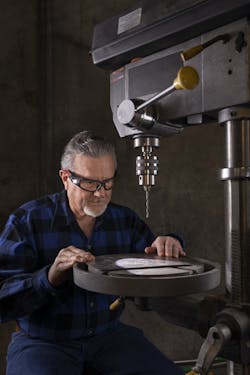Keeping equipment properly maintained to maximize uptime is one of a fleet’s top priorities, but another priority should be kept even higher: keeping the staff safe. After all, vehicles are not a fleet’s most important asset—its people are.
In the maintenance bay, the people are the technicians who keep the trucks on the road as much as possible. Taking steps to keep them safe on the job is the maintenance department’s top priority.
Keeping technicians safe is important for obvious reasons, but it has some less apparent positive results as well. Staff members who feel safe are more likely to remain with the fleet, which is more important than ever considering the current technician shortage. It also helps maintain the fleet’s uptime: an injured employee may require time away from work to recover, for example, meaning less available staff to keep vehicles up and running.
Holding regular safety meetings, keeping a clean and well-organized shop, and providing high quality safety gear are a few ways fleets can keep maintenance staff safe.
Safety training
It is imperative for fleets to hold regular safety meetings with technicians to keep them up to date with the latest safety codes and procedures. Holding regular refresher courses helps ensure everyone knows how to stay safe, how to keep the shop in safe condition, and what to do in case of an emergency.
Showing employees the location of critical safety gear is also important, especially for new hires who may not know their way around the shop yet.
Shop conditions
Another factor important to technician safety is the condition of the workspace. Employees should be trained to keep their work areas neat and to put tools and other items back where they belong after use. They should avoid cluttering their areas with tools, cords, air hoses, and other potential trip hazards. A well-organized shop is a safe shop.
There should also be a plan in place to keep the shop clean. Sweeping dirt and debris from the floors and cleaning tools and equipment are steps that should be taken on a regular basis to make sure the shop is a safe place to work. Any fluid spills should be cleaned up immediately to avoid slips and falls.
Adequate lighting is another consideration that directly impacts technician safety. Providing proper lighting in the bay allows technicians to work more effectively, but also allows them to see potential hazards that may be hidden in a poorly lit space.
Safety gear
It may seem obvious, but safety gear needs to provide safety to those using it. While most safety gear performs this function well, cutting corners and purchasing discount gear from unverified sources could put technicians at risk of an injury.
Having the proper safety gear for the task at hand is another consideration fleets need to take. For example, mobile maintenance staff should have lighted and reflective vests for proper visibility during roadside service. Likewise, technicians working on electric vehicles will need properly insulated tools as well as gloves to mitigate risk of shock from high voltage systems.
Providing proper protective gear is one thing, but making sure technicians use it is another entirely. Ensuring the safety gear in your shop is comfortable encourages technicians to keep it on all day. This may mean spending a bit more rather than purchasing the least expensive gear, but it is worth it to keep your employees safe.
Keeping maintenance staff safe is more important than ever, and not just for a fleet’s bottom line. It can also help attract and retain talented technicians and—most importantly—it is the right thing to do.
This article originally appeared on Fleet Maintenance.
About the Author
David Brierley
David Brierley is the editor of Fleet Maintenance magazine.

